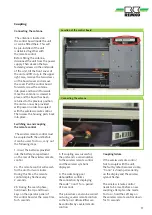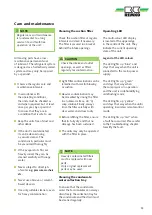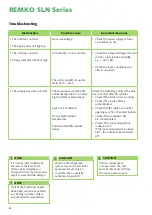
Testing the water quality
Water quality
The correct combination of chemicals in swimming pools in indoor areas is of major importance to the health of
the users and for systems in the vicinity of the swimming pool and its plant room.
Inadequately treated water leads to poor hygiene, whilst water that has been excessively treated gives off
chlorine into the air, which can irritate the eyes and lead to respiratory problems. At the same time, an incorrect
combination of chemicals in the water can lead within a very short time to the destruction of all systems -
including the dehumidifier and other systems that have been installed for air treatment.
The following tables contain the limit values for swimming pools in indoor areas in accordance with
EN/ISO 12944-2, corrosivity category C4.
These limit values must be observed, otherwise the guarantee is voided
When adding chemicals
The following guideline values apply to swimming pools when adding chemicals:
Chemical values
ppm
Free chlorine content
1,0 - 2,0
Combined chlorine content
max. 1/3 of the free chlorine content
pH value
7,2 - 7,6
Total alkalinity
80 - 150
Calcium hardness
250 - 450
Total dissolved solids
< 2000
Sulphates
< 360
With own production of chlorine
The following guideline values apply to swimming pools with own production of chlorine:
Chemical values
ppm
Salt (NaCl)
< 30000
Total dissolved solids
< 5 500
pH value
7,2 - 7,6
Total alkalinity
80 - 150
Calcium hardness
250 - 450
Sulphates
< 360
Langelier saturation index
To make sure the various water quality parameters remain within an acceptable range, the Langelier saturation
index should be applied.
8
REMKO SLN Series
Summary of Contents for SLN 45
Page 2: ......
Page 25: ...1 10 2 3 4 5 6 7 8 9 11 12 13 14 15 16 17 18 19 21 20 22 Exploded view of the unit 25...
Page 34: ...Notes...
Page 35: ......









































